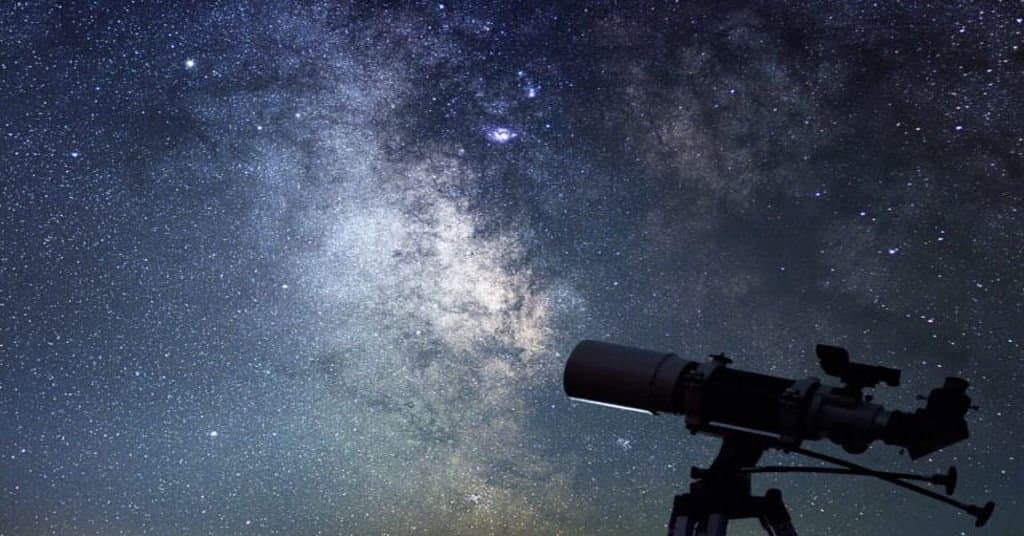Best Telescopes For Astrophotography: Journey into the Celestial Wonders
Suppose you want to make your stargazing memorized for eternity. Then, you need to capture the images and save them in your folder. Whenever you watch the picture, you will remember the whole event. For this purpose, you need something. And that is your Telescope. The Telescope opens a direct window into your dark skies and gives you an unforgettable view.
The first question in your mind is which Telescope is essential for your astrophotography. That is why we are here. If you are a beginner or seasonal astrophotographer, we give you a list of telescopes suitable for astrophotography.
The most crucial step for astrophotography is choosing the Telescope best for your work and goal. Some points are crucial to consider before selecting the Telescope.
As we get into astrophotography, we will discover that telescopes provide unmatched accuracy for detailed observations. However, it is important to note that the choice between telescopes and binoculars often comes down to personal preference. Some astronomers prioritize the portability and user-friendliness of binoculars, which makes them an excellent option for stargazing. If you are considering this alternative, our guide on the top binoculars for astronomy provides a comprehensive overview of the best choices to enhance your celestial viewing experience.
Critical considerations for selecting the best telescopes for astrophotography.
Below, we explain the essential points you must consider before selecting the Telescope.
Aperture size
The aperture size of the Telescope allows light to enter the tube. A large aperture allowing more light to enter the Telescope will produce brighter and clearer images. But there is a downside: large aperture size causes heaver the Telescope to be more expensive. You have to choose a telescope with an 80mm of aperture.
Focal length
The magnification power of the Telescope depends on Focal length. A shorter focal length provides a wider field of view, whereas a longer one increases magnification. When selecting a telescope for astrophotography, it’s essential to choose a focal length that is right for your needs. A good starting point is a focal length of 800mm.
Mount type
Two primary types of mounts are used for telescopes. Equatorial and Altazimuth.Equatorial mounts are designed to track the movement of celestial objects as they are moving in the sky, while altazimuth mounts are more straightforward. The Equatorial mount is mainly preferred for astrophotography as it allows for perfect tracking of celestial objects in the dark sky.
Weight and Portability
Telescopes are primarily heavy and challenging to transport, so it’s important to consider weight and portability when selecting a telescope for astrophotography. It would help if you chose a Telescope that is lighter in weight to transport it easily.
Optical Design
There are different optical designs for telescopes, like refractors, reflectors, and catadioptics. Each design has its strengths and weaknesses, so choosing a design that completes your needs is essential. Refractor telescopes are the most accessible to use and maintain, while reflector telescopes are more affordable. Catadioptric Telescope offers a good balance between the two.
10 Top-Notch Telescopes for Astrophotography: Perfect for beginners
There is a list of the top best telescopes for astrophotography
Celestron NexStar 4SE
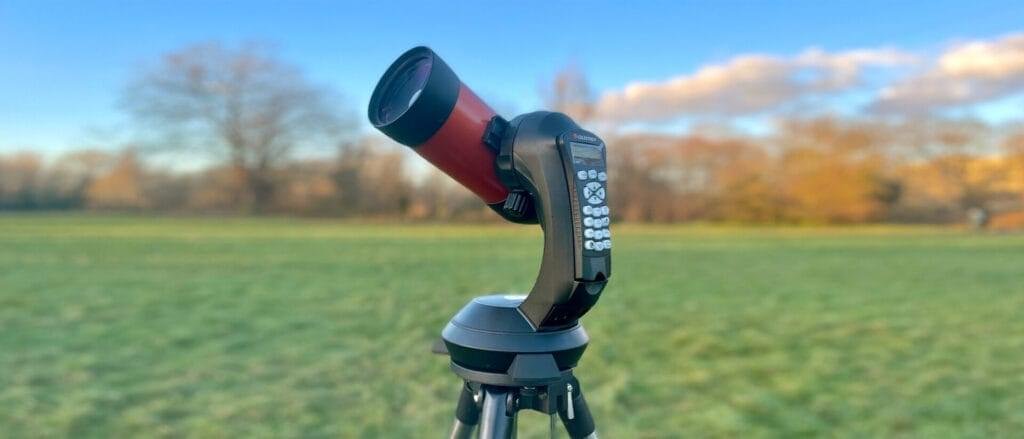
It is best for finding planets and other objects easily with this Telescope.
Specs
| Optical design | Maksutov-Cassegrain |
| Mount type | Computerized Altazimuth |
| Aperture | 4-inches / 102mm |
| Focal length | 1325mm |
| Highest useful magnification | 241x |
| Lowest useful magnification | 15x |
| Supplied eyepieces | 25mm |
| Weight | 23 lbs (10.44kg) fully assembled |
Pros
- Portable
- Easy setup
- Good quality
- Great views
- Stable tripod
- Go-to feature helpful
- Suitable for beginners
- Transportable
Cons
- Battery dependency
- Limited accessories included
- Complex setup
- Limited deep sky capability
The Celestron NexStar 4SE is an outstanding choice for stargazers looking for a high-quality telescope. It is user-friendly and produces sharp and bright images. While the sky is difficult to observe, use the sky align software feature to locate objects in the dark sky. Minimize your inconvenience. With hand, the controller feels solid and gives a new experience while using nine slewing speeds. Provide precise movement for exploration of the night sky.
The NexStar SE telescopes require a substantial amount of power to operate. We recommend you use an external power source instead of AA batteries, as a set of AA batteries will only last for a while and can be expensive to replace. While this may affect portability, carrying a portable power bank is convenient.
Overall, our review finds it the best Telescope for newbies. Because it is easy to use and generates clear and sharp images
Celestron Inspire 100AZ Refractor
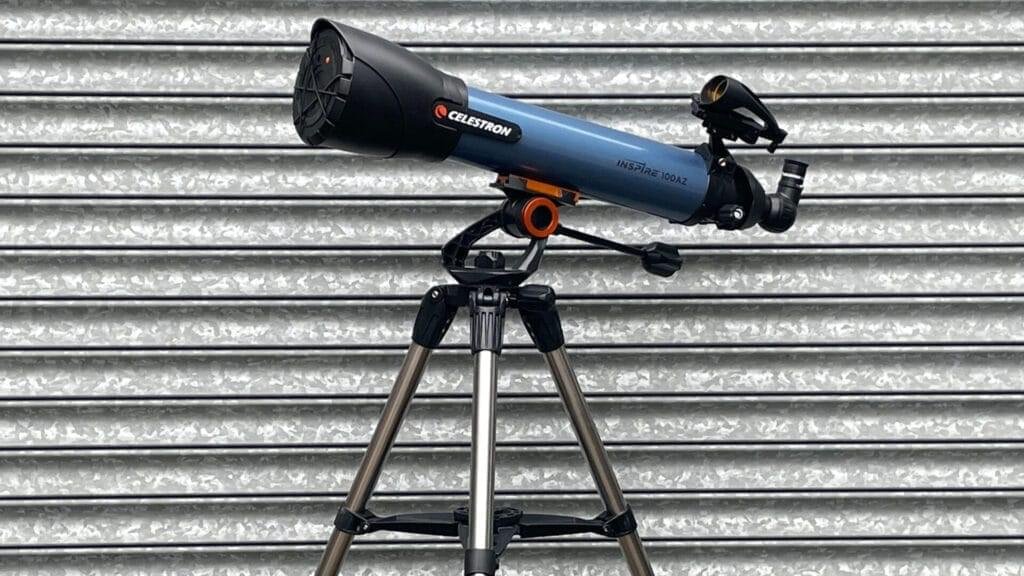
Best budget astrophotography Telescope for newbies. If you’re looking to become a telescope master, check out our ultimate guide on how to master your first telescope.
Specs
| Optical design | Refractor |
| Mount type | Alt-azimuth |
| Aperture | 3.94-inches / 100mm |
| Focal length | 660mm |
| Highest useful magnification | 241x |
| Lowest useful magnification | 15x |
| Supplied eyepieces | 10mm, 25mm |
| Weight | 20 lbs (9.07kg) |
Pros
- Excellent range of accessories
- Great intro to astrophotography
- Easy to assemble
Cons
- There is a slight false color in the optics
- Limited to short-exposure photography
If you are looking for a Telescope at a low price, the Celestron Inspire 100AZ is an excellent choice. It comes in good quality with many user-friendly features. It is worthy your money
it is easy to use. Featuring a 100mm aperture that passes a significant amount of light and provides a clear and sharp observation for the user. Like nebulas and galaxies. Moreover, long focal length provides higher magnification for detailed views of planets and other objects.
The Inspire 100AZ telescope has many accessories: Two eyepieces, a red LED flashlight to preserve night vision, an accessory tray with a smartphone adapter, and a Star Pointer Pro finder scope for locating celestial objects for simple astrophotography.
Sky watcher skymax 127 synscan AZ GoTo
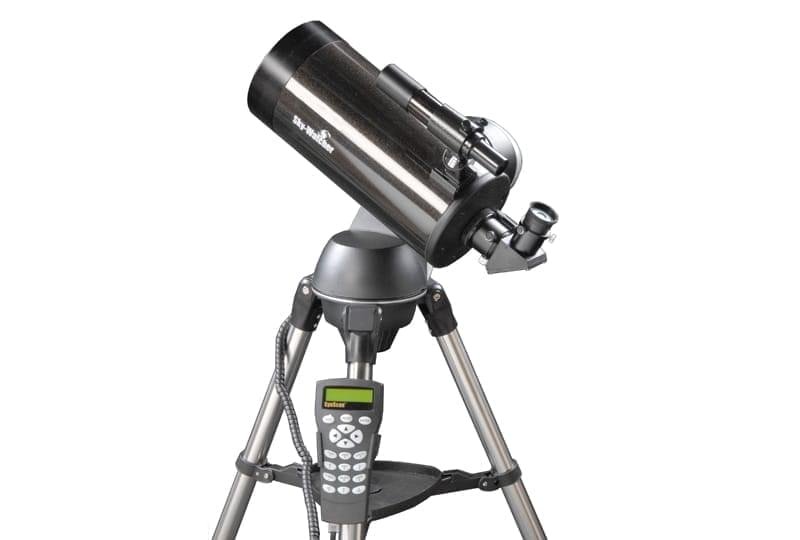
The ideal blend of modern technology and top-quality optics.
Specs
| Optical design | Maksutov-Cassegrain |
| Mount type | Motorized alt-azimuth |
| Aperture | 5-inches /127mm |
| Focal length | 1500mm |
| Highest useful magnification | 150x |
| Lowest useful magnification | 60x |
| Supplied eyepieces | 10mm, 25mm and Barlow lens |
| Weight | 39.7 lbs (18kg) |
Pros
- Good quality viewing
- Affordable price
- Fantastic views
- Great for beginners
Cons
- Low quality accessories
- Outdated GOTO controller
- No AC charger included
If Your budget is tight, you must choose Skywatcher SkyMax 127 Synscan AZ. The hand controller covers 40,000+ objects, including messier, IC SAO, and NGC. It covers both deep sky objects and solar system targets. It has a 2x Barlow lens, camera, adapter, sturdy stainless-steel tripod, and 6×3 finder scope. This deal offers excellent value for your money.
It is a manageable weight of 39.7 lbs. (18kg), and you can easily carry the Sky-Watcher Skymax 127 Synscan AZ across your destination. It gives two options for power: 8 AA batteries or a 12V power supply to operate the Servo Drive. Because batteries can lose power quickly, we recommend choosing the 12V power supply for observations with the SynScan technology without interruption. And there is no need to repurchase a battery.
Aligning the Skymax 127 is an easy process, but aligning it perfectly for the learners might take some practice. We suggest you read the manual thoroughly to understand it.
Unistellar eQuinox 2 telescope
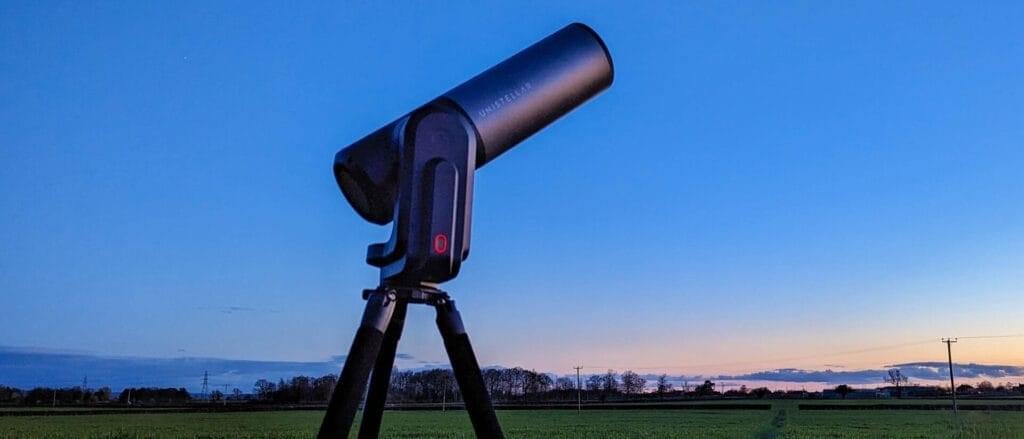
Smart Telescope comes with a clever smartphone app
Specs
| Optical design | Newtonian Reflector |
| Mount type | Motorized GoTo alt-azimuth |
| Aperture | 4.49-inches / 114mm |
| Focal length | 450mm |
| Highest useful magnification | 400x digital |
| Lowest useful magnification | 50x optical |
| Supplied eyepieces | N/A |
| Weight | 19.8 lbs (9kg) |
pros
- Detailed imaging
- Easy setup
- Citizen science programs
- Smartphone control
- Astrophotography capabilities
- Wide range of capabilities
- Engaged user community
- Automatic data processing
Cons
- Eyepiece glitch
- Long image stacking time
Suppose your budget is high, and you are interested in investing in a Telescope with advanced innovative technology. We recommend you the Unistellar eQuinox. It is the latest model of the Unistellars list and is present in the most advanced intelligent Telescope to date.
In our review. It is easy to use with durability and smart devices. We found this Telescope to be highly useable. Its unique feature is that it comes with intelligent light pollution reduction, which makes it suitable for use in harmful environments. Sometimes, other telescopes need this feature.
It is ready to use after unpacking within a minute, and you can easily sync it with the app. The application is available for download on both the Apple and Play Store. Once when it is connected with the app, you can use Telescope and customize the exposure setting to what you like the most.
Vaonis Vespera Observation Station
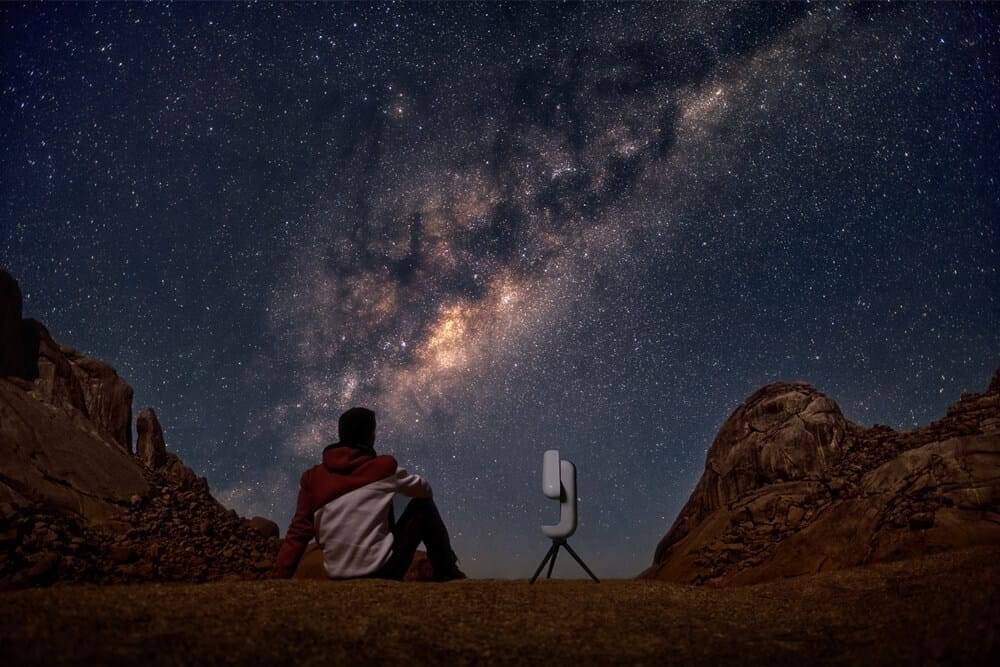
Best Telescope for tech lovers: Smart views of the dark sky for beginners
Specs
| Optical design | Apochromatic (APO) quadruplet refractor |
| Mount type | Motorized GoTo alt-azimuth |
| Aperture | 2-inches /50mm |
| Focal length | 200mm |
| Highest useful magnification | 30x equiv. |
| Lowest useful magnification | 30x equiv. |
| Supplied eyepieces | N/A |
| Weight | 11 lbs (5kg) |
Pros
- Ease of use
- Remote operation
- Image format options
- Mosaic feature
- Singularity App
- Solar Filter
- Active community on FB
Cons
- Downloading images
- Image resolution
- Hygrometer not included
- No Win or Mac apps
- Insecure WiFi
- Expensive accessories
It is approximately £1300/ $1500; this Telescope is the most thoughtful and reasonably priced. The French startup Vaonis telescope is a smaller, lighter version of its older robotic sister, the Vaonis Sellina, which we will explain later.
Vespera is Latin for ‘evening,’ which smells like a traditional Telescope. Instead of using an eyepiece, it captures the dark sky and shares it with up to 5 smartphones or tablets using its mobile app. It is like a camera that captures night sky images even in polluted towns and cities. It aims to observe the moon and planets and can make remarkable astrophotography of star clusters, nebulas, and galaxies.
Sky-Watcher Explorer 130 EQ2
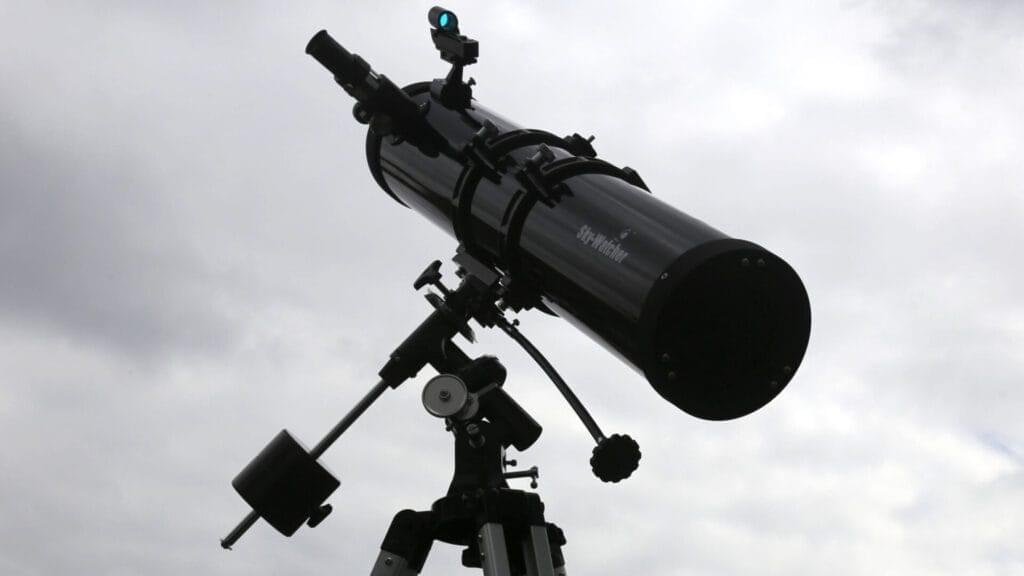
Best for exploring deep space from your lawn
Specs
| Optical design | Newtonian reflector |
| Mount type | German equatorial (EQ2) |
| Aperture | 5.1-inches / 130mm |
| Focal length | 900 mm |
| Highest useful magnification | 260x |
| Lowest useful magnification | 36x |
| Supplied eyepieces | 10mm and 25mm |
| Weight | 27.8 lbs (12.6kg) |
Pros
- Affordable equatorial mount
- Good optics
- Slow motion controls for fine adjustments
Cons
- Relatively heavy
- Manual targeting
If the sky in your area is dark, then Explorer 130 EQ2, under $300, is the perfect choice for learners and beginners for exploring and stargazing. Its equatorial mount makes it stand out in this range. When it aligned with the Earth’s axis. The mount helps to rack celestial objects as the Earth moves with a standard 130mm aperture size. This Telescope helps to explore the beauty of the deep dark sky. Especially when you are a newbie, for those interested in deep-space astronomy and deep-space observation, explore our Best Telescope For Deep Space Observation guide to learn more about suitable setups and techniques.
The Telescope is best suited for you to stargaze from your backyard. Because its weight is 12,6kg, it is ideal for taking in or out for skywatching trips without any difficulties.
Orion Skyline 6-inch Dobsonian Reflector Telescope
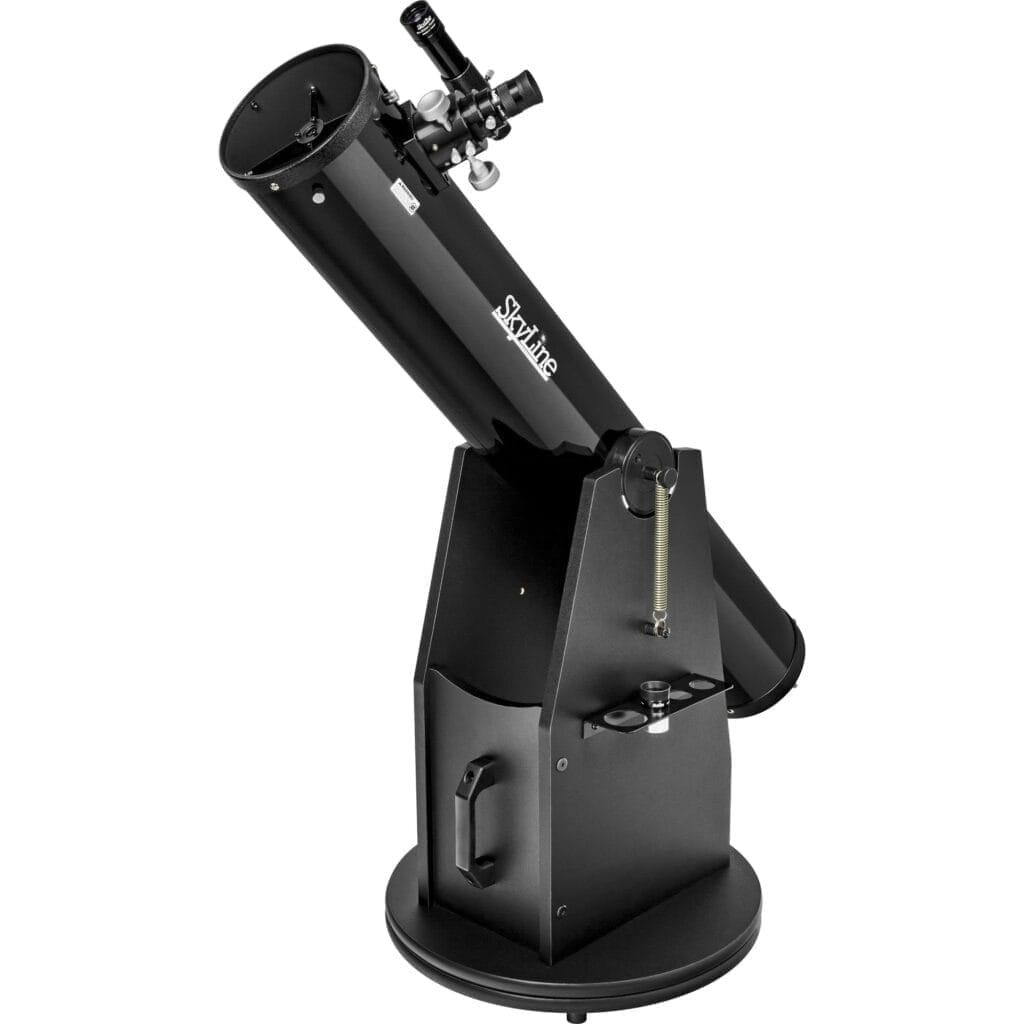
Best for getting a closer look at celestial objects
Specs
| Optical design | Reflector |
| Mount type | Alt-azimuth |
| Aperture | 6-inches / 152mm |
| Focal length | 1200mm |
| Highest useful magnification | 133x |
| Lowest useful magnification | 48x |
| Eyepieces supplied | 9mm and 25mm |
| Weight | 37.5 lbs (17kg) |
Pros
- Good optics
- Sturdy build
- Clear images
- Easy setup
Cons
- Focuser issues
- Spring tension
Suppose you want to see things in detail. In that case, the Orine Skyline 6-inch telescope is a fantastic choice for learners and beginner astronomers because it is easy to see natural and high-quality optics.
This telescope feature is a 152mm Objective les that allows tons of light to result in a clear, cleared view of night sky targets. Multi-coated optics increase your experience of sky viewing and provide a clear image of celestial objects in the dark sky. It has a focal length of 1200mm; through this, you can observe details like creators on the moon and features. It provides magnification of up to 133x. That enables a detailed look at celestial objects.
Celestron Omni XLT 102
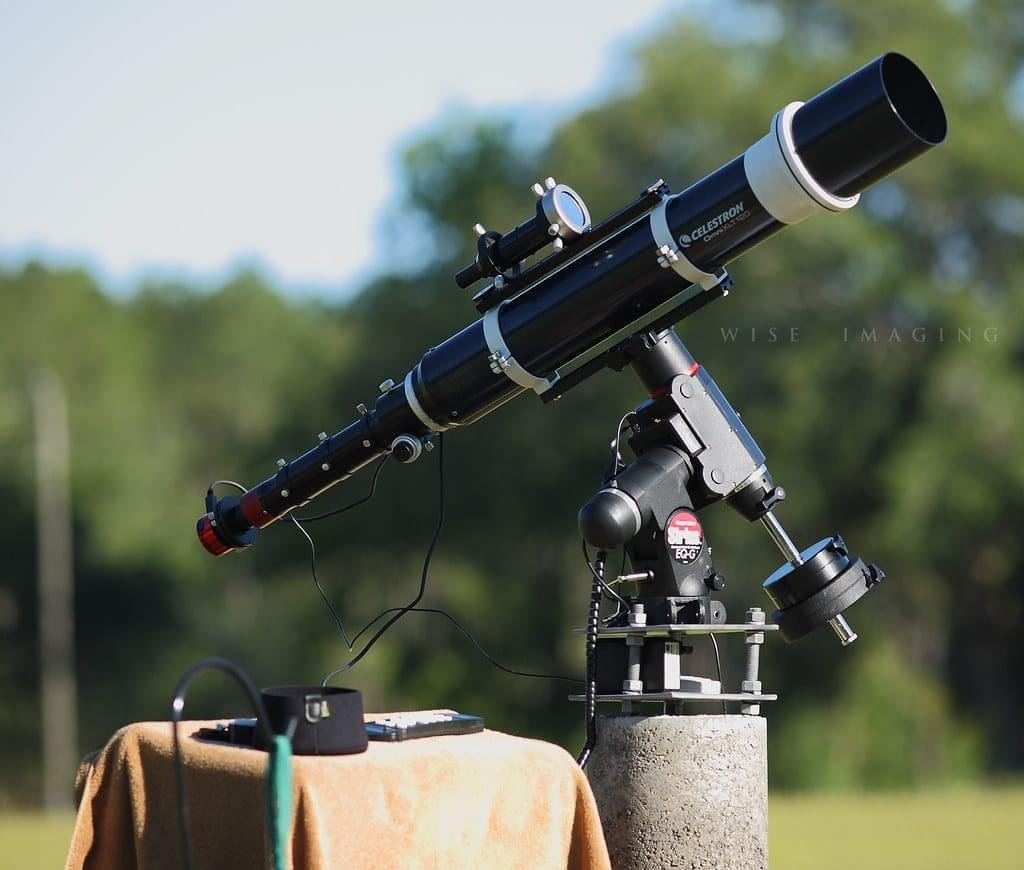
Best for intermediate astronomers and Suitable for those who require good-quality optics
Specs
| Optical design | Refractor |
| Mount type | Equatorial |
| Aperture | 4.02-inches / 102mm |
| Focal length | 1000mm |
| Highest useful magnification | 283x |
| Lowest useful magnification | 15x |
| Supplied eyepieces | 25mm |
| Weight | 33 lbs (15kg) |
Pros
- Quality build & appearance
- Sturdy EQ mount for tracking
- Detailed instruction booklet
- Good optics for price
- Includes decent eyepiece
- Expandable with accessories
- Smooth focuser & controls
- Quick assembly & alignment
cons
- Chromatic aberrations present
- Finder scope below-par
- Heavy & not easily portable
- Logistics issues with Amazon
The Celestron Omni XLT 102 is for learner-level skywatchers. That open window in space for intermediate astronomers. Especially those who have learned setting circles and are now using ascension and declination coordinates on the supplied quality CG4 German mount.
It is coated to optimize for incoming light. That improves your viewing experience. The Telescope also features technologies like aspheric shaping to reduce spherical aberration (that affects light focus). It is resulting in sharper and more detailed images. It also represents the natural color of celestial objects.
Celestron Advanced Vx 8 EdgeHD
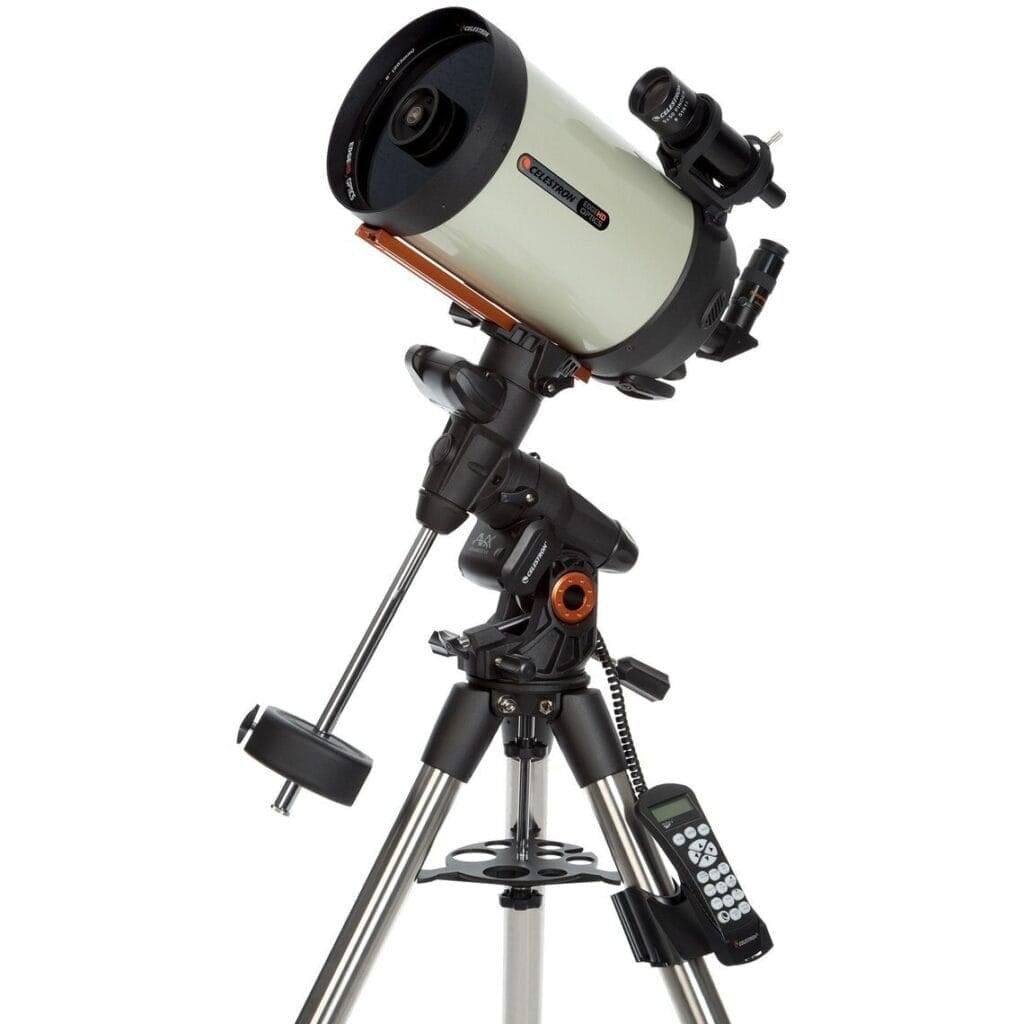
Best for a sharper field of view and one for veteran astronomers
Specs
| Optical design | Schmidt-Cassegrain |
| Mount type | Motorized equatorial |
| Aperture | 8-inches / 203.2mm |
| Focal length | 2032mm |
| Highest useful magnification | 480x |
| Lowest useful magnification | 29x |
| Supplied eyepieces | 40mm |
| Weight | 61 lbs (27.67kg) |
Pros
- Excellent optics
- Solid mount and tripod
- Accurate GoTo and tracking
- Quality craftsmanship
- Good for visual use
- Superb for astro photography
- Good light transmission
- Tracks well without autoguider
Cons
- Hand controller issues
- Heavy without handles
- Outdated accessories
- Poor customer service
- Manual quality issues
- Pricey for the value
Celestron improves the Schmidt-Cassegrain telescope, especially for astrophotography. Normally, it provides a curved focal plane that doesn’t match the flat surface CCD camera sensor. This makes field curvature; the result, the edges of stars appear blurry. However, Celestron EdgrHD technologies solve this issue by giving a perfectly flat field. This allows astrophotographers to capture sharp images of stars.
The optical tube assembly includes Celestron’s Advanced VX mounts as a bonus for astrophotographers. It allows the capture of Celestron objects across a meridian (an imaginary north/ south line) without requiring any meridian flip. It can also correct errors while tracking objects and provide an auto guider port.
Sky-Watcher Skymax 150 PRO
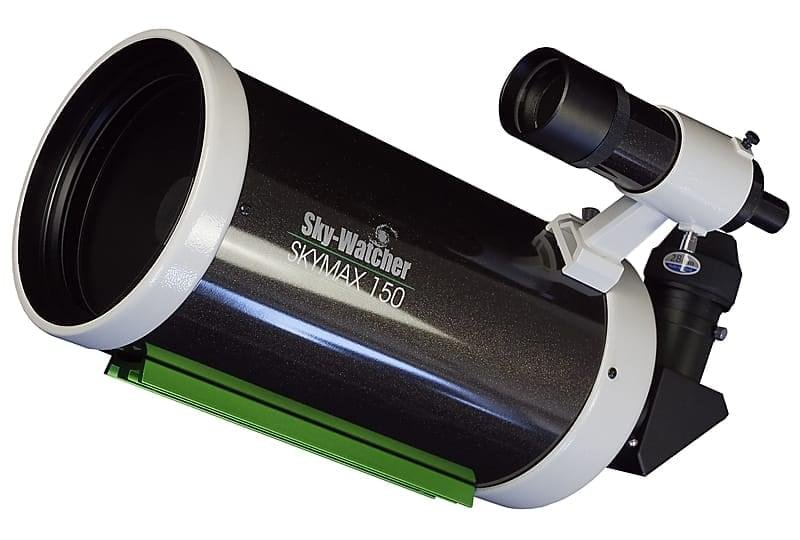
Improve the night skywatching experience with accessories. Best for astrophotography
Specs
| Optical design | Maksutov-Cassegrain |
| Mount type | Equatorial (EQ-5 Pro) |
| Aperture | 5.90-inches / 150mm |
| Focal length | 1800mm |
| Highest useful magnification | 450x |
| Lowest useful magnification | 36x |
| Supplied eyepieces | 28 mm |
| Weight | 13.23 lbs (6kg) |
Pros
- Powerful Magnification
- Compact and Portable
- Ease of Use
- Excellent Performance
- Value for Money
- Great Optics
- Sharp and High-Contrast Views
- Versatile
cons
- Learning Curve
- Accessories Quality
If your hobby is astrophotography, the Skymax 150 is great, offering excellent value to pick. Some high-quality model also has equatorial mounts. They are suitable for short- and long-range night sky exposure for astrophotography. This Telescope comes in a 28mm focal length eyepiece with 64x magnification to capture your dreamed celestial object clear and sharper.
It is portable with 13.23 kg (6kg). Make it easy to use in your backyard. Its accessories include CCD and DSLR cameras, filter wheels, and other add-ons.
Accessories for Astrophotography
Camera Adapters
These adapters allow you to attach your camera to the Telescope. You are making it easier to capture your favorite celestial objects.
Filter for light pollution.
These filters help you to adjust the light that is entering your Telescope. The result comes with sharp, clear, and detailed images.
Auto-guiders
It helps you to track celestial objects in the night sky more quickly, so you can focus on the same object for a long time, resulting in sharp, clear, and perfect images. It uses a star guide to make slight movements to the Telescope as needed.
FAQs
What is the best Telescope for a beginner in astrophotography?
The Celestron AstroMaster 130EQ is an excellent option for beginner astrophotography. It has a tripod, finder scope, mount, eyepieces, and smartphone adapter.
How vital is aperture size in astrophotography?
Aperture size is one of the most important factors before selecting a telescope for astrophotography. The larger the aperture of a telescope allows for gathering more light, resulting in brighter and clearer images. The excellent range is to select between 80mm.
How vital is aperture size in astrophotography?
Aperture size is one of the most important factors before selecting a telescope for astrophotography. The larger the aperture of a telescope allows for gathering more light, resulting in brighter and clearer images. The excellent range is to select between 80mm.
Can I use my regular camera for astrophotography?
Yes, you can use your regular camera for astrophotography. However, you may need to invest in equipment such as a tripod and a remote shutter release.
What is the average cost of a good astrophotography telescope?
The magnification and clarity of the Telescope can significantly differ based on its features and quality. For early birds, its range is $800 to $1500, while for veterans costs $1500 to $3000
How do I choose the right location for astrophotography?
When choosing a location for astrophotography, it’s essential to consider the Dark sky at your head. The International Dark-Sky Association (IDSA) has a database of International Dark Sky Places (IDSPs) that meet specific criteria. To locate dark-sky locations, you may also use mobile applications and websites.

